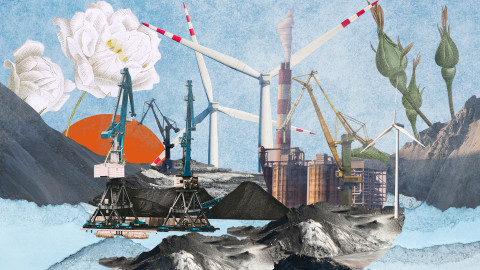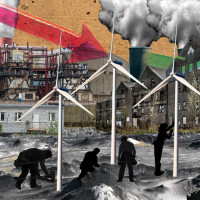Energy Transition Mythbusters: Myth #5 Intellectual property rights help facilitate the energy transition
Topics
Intellectual Property (IP) rights are seen as central to speeding up innovation and encouraging investment. In the context of the energy transition, these laws are supposed to benefit private firms by increasing their capacity to profit from new low-carbon technologies, make the market more dynamic and accelerate the renewable transition. But in reality, and after the COVID-19 pandemic, IP regimes have proven to hinder an equitable access to technologies, especially in low-income countries. Alternatives where a global and public approach is central should benefit equitable technology transfers, knowledge sharing instead of reinforcing existing and emerging monopolies.

Fourate Chahal El Rekaby
Key takeaways
-
Intellectual property rights do NOT help facilitate the energy transition.
-
IP enforcement exacerbates global inequality by enabling firms in wealthy western countries to gain monopoly control over the production of new low-carbon energy technologies. Just four manufacturers account for 55 per cent of the world’s wind turbine production.1
-
In turn, IP slows down the energy transition. Chatham House estimates that because of patents, new inventions in the energy sector take between two and three decades to reach the mass market, with an average of 24 years for most renewable energy innovations.
-
State-led research has been at the heart of R&D for renewables, challenging the narrative of profit-oriented private company-led innovation and thus undermining the need for IP protections.2
-
A Global Public Goods approach based on sharing knowledge and technology requires challenging the intellectual property system and can facilitate the distribution of renewable technology globally through public-public partnerships.3
The myth
Intellectual property (IP) laws aim to protect investors by monopolising IP holders’ rights to use, license, and profit from new innovations. Within liberalised energy markets, IP rights are seen as central to speeding up innovation and encouraging investment.
According to advocates of this myth, without IP, private firms would lack the incentives necessary to push forward the energy transition. This is because IP facilitates private firms’ capacity to profit from new low-carbon energy technologies, ensuring that these technologies cannot be developed by rival actors and, in turn, that firms’ market shares are protected.
The International Renewable Energy Agency (IRENA) describes patents and intellectual property as an ‘engine of technological innovation’ and sees supporting and strengthening intellectual property regimes as a means to accelerate the renewable transition.4
The reality
The COVID-19 pandemic has brought into focus the fact that IP regimes serve to inhibit equitable access to technologies, especially in low-income countries. IP constraints meant that the rights and knowledge required to produce vaccines and medicines were left to a handful of companies, blocking low-income countries from producing vaccines while securing profits for firms in the wealthiest countries.5
The situation with IP and the energy transition is very similar. Recognizing the artificial barrier that IP regimes pose to renewables, António Guterres, the UN Secretary-General remarked: ‘renewable energy technologies, such as battery storage, must be treated as essential and freely-available global public goods. Removing obstacles to knowledge sharing and technological transfer – including intellectual property constraints – is crucial for a rapid and fair renewable energy transition.’6
Indeed, contrary to claims made by IP proponents, IP is slowing down clean energy investments while simultaneously exacerbating global inequality. In fact, rather than IP regimes, it is state-led research and development programmes that are vital for renewable technology innovation. An alternative Global Public Goods (GPG) approach, which centres equity, justice, and a swift transition, requires the loosening of IP constraints and demands a system that supports the sharing of key technologies, rather than one that constrains technology distribution.
IP rights exacerbate global inequality
The Agreement on Trade Related aspects of Intellectual Property (TRIPS) is the institutional background for IP enforcement for World Trade Organization member states. Although TRIPS contains methods for technology transfer to low-income countries, these have not remedied the global inequality of access to renewables.7 Instead, IP restrictions have established a renewable energy oligopoly whereby the production of clean energy technologies is limited to a handful of companies, largely in wealthy countries.8 In turn, IP regimes are contributing to the global inequality between the global rich and poor.
Research has indicated that there is a monopoly of climate mitigation technologies and patents in high-income countries, and that lower-income countries are rarely given licences to use patented technologies.9 A broad swathe of policy-makers, activists, and governments have called for the loosening of IP regimes pertaining to low-carbon energy technologies for low- and middle-income countries.10
Four manufacturers (Denmark’s Vestas, Spain’s Siemens Gamesa, China’s Goldwind, and General Electric of the US) accounted for 55 per cent of all wind turbine production in 2019 and 73 per cent of solar photovoltaic (PV) production took place in China in 2017.11 Furthermore, of the top 10 wind turbine manufacturers globally, every single firm was in Europe, the United States, or China.12 This global oligopoly of renewable production is one of the reasons why the entire continent of Africa produces just 1.5 per cent of the world’s solar energy, despite having the greatest potential productive capacity.13, 14 Indeed research indicates that weaker intellectual property reinforcement would likely help local initiatives develop more rapidly within Africa.15
Moreover, IP regimes are contributing to neocolonial extraction in the energy sector. Most renewables are dependent on minerals such as cobalt and copper obtained from the global South,16 and yet only countries in the global North have the IP rights to produce new renewables. Hence, the global South is forced to relinquish its resources for the profits (and energy consumption) of the global North.17

TLPOSCHARSKY/Flickr/CC BY 2.0
IP rights slow down clean energy investment
As explained above, IP rights prevent areas of the world rich in abundant renewable energy potential from utilising this. As well as raising issues of global justice and equality, a further consequence is that the energy transition is slowed down. By limiting the right to produce new renewable technologies to those who hold IP rights, companies, municipalities, and other actors around the world are prevented from adopting these technologies, even when there is a genuine desire to do so.
London-based think-tank Chatham House estimates that because of patents, new inventions in the energy sector take between two and three decades to reach the mass market, with an average of 24 years for most renewable energy innovations.18 By the time these technologies are widely available, the world economy should already be close to net-zero emissions.
Focusing on IP rights obscures the role of the state in low-carbon innovation
By positioning IP protections as the engine of renewables innovation, proponents of this myth hide the fact that state-driven research and development (R&D) is at the centre of new renewable technology. We have already seen in Myth #1 that the public sector provides the majority of funds for the renewable transition. One important dimension of this, as research by the renowned economist Mariana Mazzucato and her team point out, is that it has actually been state-sponsored research programmes that have created the knowledge and technology necessary to produce renewable energy.19
For example, Vestas and General Electric, two of the largest manufacturers of utility-scale wind turbines, both drew heavily on research that was funded by the US and Danish governments.20 In fact, Vestas and Bonus (Danish producers of wind turbines) purchased patents from Danish government-sponsored research programmes and used this knowledge to develop their wind turbine technologies.21
Calculations on the percentage of global R&D funds that come from public sources vary, but in 2011, the European Commission estimated that around 45 per cent of R&D funds for solar energy originated from public sources,22 and research indicates that this share is increasing over time.23 This is particularly important considering that public investment and policies tend to have a significant and positive effect on private investment towards R&D in renewables.24
We need a Global Public Goods approach
In contrast to the current IP regime, an alternative Global Public Goods (GPG) approach sees access to green technologies as a public good for all and, in turn, will accelerate the renewable energy transition.
A GPG approach would challenge the current system of governments sponsoring R&D for private profits, and instead encourage active sharing and collaboration on research on new renewable technology.25 IP barriers for new renewable technologies would be replaced with a system where governments are encouraged to share knowledge and collaborate through public-public partnerships.
Rather than invest in R&D to maximise profits, a GPG approach centres the goals of efficiency, efficacy, and equity, promoting technology transfer and knowledge-sharing rather than reinforcing monopolies on intellectual property. Further, by promoting partnerships between public entities spanning high-income and low-income countries, a GPG approach has the potential to close the gap between the global rich and global poor in terms of access to low-carbon energy technologies.





